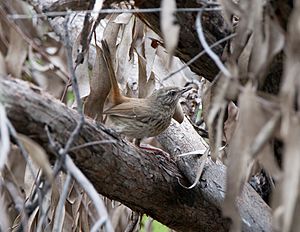Chestnut-rumped heathwren facts for kids
Quick facts for kids Chestnut-rumped heathwren |
|
|---|---|
 |
|
| Conservation status | |
| Scientific classification | |
| Genus: |
Hylacola
|
| Species: |
pyrrhopygia
|
| Subspecies | |
|
|
| Synonyms | |
|
|
The chestnut-rumped heathwren (Hylacola pyrrhopygia) is a small bird found only in Australia. It lives in temperate and subtropical forests and heathlands. This bird is part of a family called Acanthizidae.
Contents
About the Name
This bird was first described in 1827 by two scientists, Nicholas Aylward Vigors and Thomas Horsfield. Its scientific name, Hylacola pyrrhopygia, tells us a bit about it.
The name Hylacola comes from Greek and Latin words. Hylē means 'woodland' and -cola means 'dweller'. So, it means 'woodland dweller'. The second part, pyrrhopygia, comes from Greek words meaning 'flame-coloured' or 'red' and 'rump'. This describes its reddish-brown rump. People sometimes call it the scrub warbler.
There are three slightly different types, or subspecies, of the chestnut-rumped heathwren:
- Hylacola pyrrhopygia pyrrhopygia: Found in New South Wales and Victoria.
- H. p. parkeri: Lives in the Mount Lofty Ranges of South Australia.
- H. p. pedleri: Found in the southern Flinders Ranges of South Australia.
What It Looks Like
The chestnut-rumped heathwren is a small bushland bird. It has an olive-brown back. Its most noticeable feature is its reddish-brown rump and tail. Its chest is streaked with brown and white. The belly and sides are grey-buff.
Its tail usually stands up. It has a dark band near the end with a white tip. Both male and female birds have a dull white eyebrow. Their eyes are yellow, and their beak, legs, and feet are grey. This bird measures about 14 centimeters (5.5 inches) long. The different subspecies look very similar.
Where It Lives
You can find the chestnut-rumped heathwren in southeastern Australia. Its range stretches from southeast Queensland through eastern New South Wales, Victoria, and southeast South Australia.
In Victoria, it lives inland near the Grampian Mountains and Bendigo. However, it is more common near the coast. In New South Wales, it can be found inland as far as the Warrumbungles. There are also small groups in the Flinders and Mount Lofty Ranges, and the Fleurieu Peninsula in South Australia.
This bird prefers heath areas, which are open lands with small shrubs. It also likes the thick undergrowth in forests and woodlands. It tends to stay in one area and is not very common.
How It Behaves and Breeds
The chestnut-rumped heathwren is usually shy. It likes to stay hidden. But during breeding season, from July to November, both males and females sing. They sing from a perch on a bush, but still try to stay partly hidden.
Their song is rich and melodious. It sounds like "chi-chi-tu-weet" or "kwe-reep." They can also copy the songs of other birds. When they are alarmed, they make a harsh "zeet" sound.
The heathwren builds a round, dome-shaped nest. It places the nest on or near the ground. Nests are often found in clumps of grass or thick bushes. They build nests from dry grass, bark, and roots. The nests can look a bit messy.
A female bird usually lays three or four eggs. She sits on the eggs for 14 to 16 days. The eggs are salmon-pink with light chocolate-brown freckles. The freckles are more noticeable at the larger end. Each egg is about 20 by 15 millimeters (0.8 by 0.6 inches).
What It Eats
The chestnut-rumped heathwren looks for food alone, in pairs, or in small groups. Sometimes, it joins other birds like Acanthiza species and variegated fairywrens.
Its diet mainly consists of small creatures called arthropods. These include flies, spiders, moths and their larvae (caterpillars), ants, cicadas, and cockroach egg-sacs. It also eats seeds from different types of grass.
Conservation
The number of chestnut-rumped heathwrens is decreasing. However, the IUCN currently lists it as a species of Least Concern. This means it is not in immediate danger globally.
But in some parts of Australia, it faces more serious threats. It is listed as Endangered in South Australia. It is also listed as Vulnerable in Victoria. The main problems for this bird are the loss and breaking up of its habitat. Also, predators like introduced animals can harm them.
See also
 In Spanish: Sedosito culirrojo para niños
In Spanish: Sedosito culirrojo para niños


